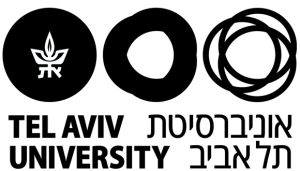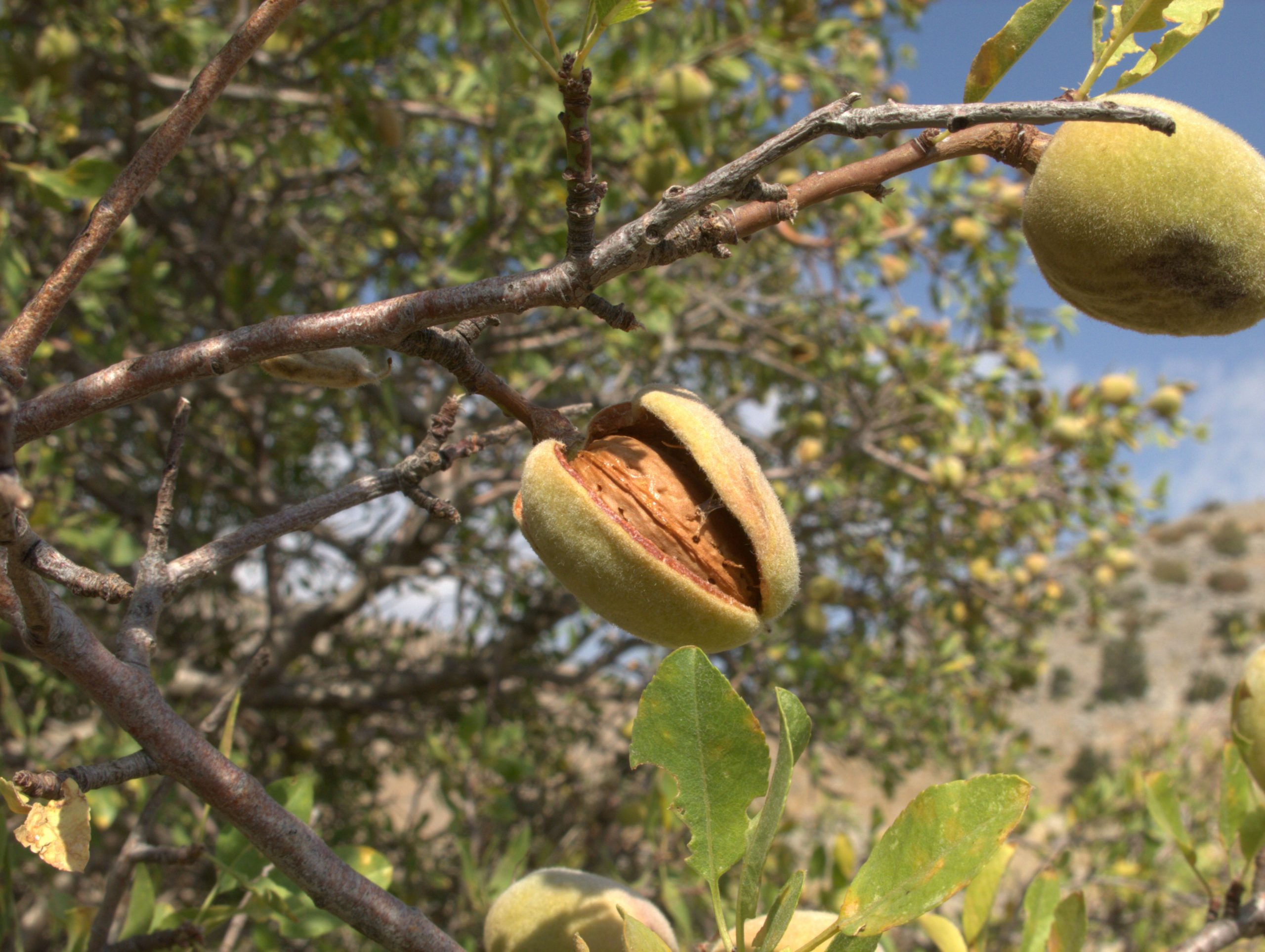Almond, לוּז / שָׁקֵד, Amygdalus communis
Back to FloraAlmond
שָׁקֵד (šāqēd), לוּז (lûz)
Amygdalus communis
Modern Hebrew: שָׁקֵד (šāqēd), שְׁקֵדִיָּה (šəqēdîyâ)
Image gallery
Biblical data
Introduction
The common noun שָׁקֵד (šāqēd) occurs twice in the singular in the Hebrew Bible (Jer 1:11; Qoh 12:5), and the plural שְׁקֵדִים (šəqēdîm) on two further occasions (Gen 43:11; Num 17:23). The apparently denominative pual participle מְשֻׁקָּד (məšuqqād) occurs six times, always to describe the bowls on the branches and on the central stem of the lampstand in the tabernacle (Exod 25:33 [x 2], 34 = 37:19 [x 2], 20). The qal verb שָׁקַד (šāqad)—explicitly associated with the noun in Jer 1:12—also occurs twelve times (Isa 29:20; Jer 1:12; 5:6; 31:28 [x 2]; 44:27; Pss 102:8; 127:1; Job 21:32; Prov 8:34; Dan 9:14; Ezra 8:29). Like other botanical terms, the singular form appears to refer to the living plant, the plural to its usable product—in this case, fruit.
לוּז (lûz) occurs once in the Hebrew Bible as a common noun (Gen 30:37) and eight times as a toponym, the Canaanites referring to Bethel by this name (Gen 28:19; 35:6; 48:3; Josh 18:13 [x 2]; Judg 1:23). The name also denotes a place close to Bethel (Josh 16:2) and a city in “Hittite country” built by a Canaanite exile from Bethel (Judg 1:26). From the ancient translations onwards, לוּז has customarily been understood as a synonym for שָׁקֵד.
Distribution within the Bible
The form שָׁקֵד occurs twice in the Bible:
- Once in a destruction prophecy (Jer 1:11).
- Once in the wisdom literature (Qoh 12:5).
The form שְׁקֵדִים occurs on two further occasions, both in narrative (Gen 43:11; Num 17:23).
The single incidence of לוּז as a common noun occurs in narrative (Gen 30:37).
Parts, Elements, Features that Are Specified in the Bible
The quality of שְׁקֵדִים (Gen 43:11).
Their growth (Num 17:23).
The rod (מַקֵּל) of the שָׁקֵד (Jer 1:11) and לוּז (Gen 30:37).
The blossoming of the שָׁקֵד (Qoh 12:5; cf. Song 6:11; 7:13).
Function in Context
In a realistic reference, the rod of the לוּז is described as white when peeled (Gen 30:37), being paired here with the rods of both the לִבְנֶה and עֶרְמוֹן.
שְׁקֵדִים are also cited as an example of the choice produce of the Land of Israel, appropriate to be presented to dignitaries (Gen 43:11). Here, they constitute the final item in a list of six products to be brought from the Land of Israel to Egypt as representing the choice produce of the former: מְעַט צֳרִי וּמְעַט דְּבַשׁ נְכֹאת וָלֹט בָּטְנִים וּשְׁקֵדִים (Gen 43:11). All six items appear to be easily preservable plant or animal products.
Their growth on a staff following the emergence thereupon of פֶּרַח and צִיץ miraculously signify the divine election of the Aaronide priests (Num 17:23).
A rod of a שָׁקֵד signifies via word play the state of being watchful or eager to seize an opportunity (שֹׁקֵד) (Jer 1:11–12). This figure is loosely paired with that of a boiling pot (v. 13).
The blossoming of the שָׁקֵד indicates an aging phenomenon (Qoh 12:5) of some type, paired with the sagging (?) of the חָגָב and breaking (?) of the אֲבִיּוֹנָה (ibid).
Contributor: Dr. Raanan Eichler, Department of Bible Studies, Bar Ilan University
History of Identification
Identification History Table
Life & Natural Sciences
English: Almond
Hebrew: שָׁקֵד (šāqēd), לוּז (lûz
Scientific Name: Amygdalus communis
ID
Kingdom: Plantae
Division: Angiospermae
Class: Dicotyledoneae
Order: Rosales
Family: Rosaceae
Genus: Amygdalus
Species: Amygdalus communis
Originating in the Middle East (Browicz & Zohary 1996), the Amygdalus communis or almond tree most likely gave the neural structure in the brain known as the amygdala its name, due to their resemblance in shape (AbuHasan et al. 2021). Like many other edible fruit trees in the Rosaceae family, it is a winter deciduous species, shedding its leaves during the winter months (http://israelalmond.co.il/en). Unusually, however, it blooms before leafing, the fragrant flowers attracting bees that pollinate it, thereby enabling the formation of fruit and seeds (www.wildflowers.co.il/english). The bitterness of wild almonds seeds is due to the presence of cyanide. Cultivation and domestication have stripped the Amygdalus communis of this poisonous element, almonds thus now frequently being regarded as sweet (Browicz & Zohary 1996).
The Hebrew Bible refers to the almond tree by two names: שקד (shaqed) and לוז (luz). According to botanical research field of naming and classifying plants the two names stand for two different trees. The first (שקד [shaqed]) signifies the almond tree, the second (לוז [luz]) the Corylus plant. But since the Corylus is not native to Israel or its surroundings (Feliks 1968), this entry discusses only the שקד (shaqed).
Life History
The almond tree is bare and in hibernation between November and February, flowering between early January and late March (https://flora.org.il/en). After flowering, it develops a leafy foliage and turns green. The fruit begin to emerge around March, reaching their maximum size in June. As the heat intensifies over the summer months (July and August), the fruit ripen fully, the drupes split open and the orchard becomes ready for harvesting (http://israelalmond.co.il/en).
Characteristics that Appear in the Bible
A miraculous simultaneous growth of flowers, leaves and ripened fruits on Aaron’s staff. While a tree may bear both flowers, leaves and young fruit during a specific period, the desynchronization between the flowering and fruit ripening seasons (~January‒March vs. ~June – August) makes this a very unlikely occurrence (https://flora.org.il/en; http://israelalmond.co.il/en). The simultaneous flowering and fruit-bearing nature of Aaron’s staff thus falls under the category of the “miraculous.”
White colored inner branches of the almond tree. When healthy, the inner branches are light and bright in color (Mircetich et al. 1976).
Blooming at a unique time. In Hebrew, the name of the tree plays on the root š-q-d, suggesting that it is characterized by its “eagerness to seize opportunities” (Hareuveni 1980). Its early flowering, at the beginning of winter, when there are hardly any other flowers, gives it an advantage over its competitors for pollinators (Michael 1994; London 2001), necessary in light of the bitter taste the amygdalin imparts to the almond plant’s nectar (London 2001; Singaravelan et al. 2005). Amygdalus communis also appears to flower when the temperature of the soil and the water it stores begins rising (Hareuveni 1980). However, while several plant species are affected by high temperatures governing the point at which they flower (Rylski 1972; Hall et al. 1977), the almond tree’s “eagerness” more likely reflects a combination of both factors – the low competition for pollinators and the high temperatures.
Other Characteristics
Morphological Characteristics
A perennial tree, the Amygdalus communis can survive for 100 years. While customarily growing to between three and eight meters, it can exceed 20 meters under optimal conditions (Gradziel 2011).
Flowers. The almond tree is monoecious, male and female flowers appearing on the same tree. Each possesses five petals and 10‒30 stamens. Arranged in groups on the exposed stems, the bisexual flower buds open gradually in pink or white colors (Browicz & Zohary 1996) and are pollinated by bees (www.wildflowers.co.il/english).
Leaves. The leaves are simple, elongated, and toothed, between one and five centimeters long (Browicz & Zohary 1996). During the winter the almond tree has no leaves, and flowering begins (https://flora.org.il/en). Only after flowering, does the tree develops a leafy foliage.
Fruit. The fruit of the Amygdalus communis are known as drupes—fleshy meat with a hard, dry seed released for dispersal. They are thus not nuts, which are hard-shelled fruits that do not open to release the seed (Lorts et al. 2008). Non-spiny (Browicz & Zohary, 1996), with an average length of ca. 3 cm, the fruit has an outer shell that splits in half, usually falling when ripe (www.wildflowers.co.il/english).
Seeds. Almond seeds have hard shells that only split under pressure, remaining on the tree after the fruit shell falls off (www.wildflowers.co.il/english). Wild almond seeds contain a poisonous substance named amygdalin that, when chewed, is converted to a derivative of cyanide. Given the seeds’ bitter taste, this mechanism is suspected to protect them from being eaten by animals (Sánchez-Pérez et al. 2008).
Distribution and Habitat
The almond is distributed across the East Mediterranean and West Irano-Turanian regions (www.wildflowers.co.il/english). Prior to the advent of agriculture, Amygdalus communis appears to have been restricted to the Levant (Israel, Jordan, Lebanon, Syria, most of Turkey), only later becoming naturalized in Middle Asia. The available archaeological evidence also supports its origin along the Eastern Mediterranean shoreline, the first extant evidence of almond domestication dating to Bronze Age sites in the Levant (Browicz & Zohary 1996). Today, California is the primary production region in the world (Badenes & Byrne 2012)—far distant from of the almond’s center of origin, though nowadays almonds are grown worldwide.
The tree is common in maquis and limestone soil from mesic Mediterranean regions to more arid Mediterranean zones (www.wildflowers.co.il/english).
Bibliography
AbuHasan, Q., V. Reddy, & W. Siddiqui. 2021. “Neuroanatomy, amygdala.” StatPearls: https://www.ncbi.nlm.nih.gov/books/NBK537102/.
Badenes, M. L., & D. H. Byrne. Eds. 2012. “Fruit Breeding.” Pages 697‒729 in vol. 8 of Handbook of Plant Breeding. New York: Springer.
Balaguer-Romano, R., A. Barea-Marquez, F. J. Ocaña-Calahorro, J. M. Gomez, E. W. Schupp, J. Zhang, & R. R. de Casas. 2021. “The Potential Role of Synzoochory in the Naturalization of the Almond Tree.” Basic and Applied Ecology 50: 97‒106.
Browicz, K., & D. Zohary. 1996. “The genus Amygdalus L. (Rosaceae): Species Relationships, Distribution and Evolution under Domestication.” Genetic Resources and Crop Evolution 43: 229‒47.
Feliks, Y. 1968. Plant World of the Bible. Ramat-Gan: Masada.
Gómez, J. M., E. W. Schupp, & P. Jordano. 2019. “Synzoochory: The Ecological and Evolutionary Relevance of a Dual Interaction. Biological Reviews 94: 874‒902.
Gradziel, T. M. 2011. “Origin and Dissemination of the Almond.” Horticultural Reviews 38: 23‒80.
Hall, A. E., M. M. Khairi, & C. W. Asbell. 1977. “Air and Soil Temperature Effects on Flowering of Citrus.” Journal of the American Society for Horticultural Science 102: 261‒63.
Hareuveni, N. 1980. Nature in our Biblical Heritage. Neot Kedumim: Neot Kedumim.
London, I. 2001. “Competition for Pollination between Cultivated Almonds and Wild Flowers.” MSc thesis, Tel Aviv University.
Lorts, C. M., & T. Briggeman. 2008. “Evolution of Fruit Types and Seed Dispersal: A Phylogenetic and Ecological Snapshot. Journal of Systematics and Evolution 46: 396‒404.
Martinoli, D., & D. Jacomet. 2004. “Identifying Endocarp Remains and Exploring their use at Epipalaeolithic Öküzini in Southwest Anatolia, Turkey.” Vegetation History and Archaeobotany 13: 45‒54.
Michael, A. 1994. “The Adaptation of Almond (Amygdalus communis L.) for Blooming under Winter Conditions.” MSc thesis, Tel Aviv University.
Mircetich, S. M., S. K. Lowe, W. J. Moller, & G. Nyland. 1976. “Etiology of Almond Leaf Scorch Disease and Transmission of the Causal Agent.” Phytopathology 66: 17‒24.
Rylski, I. 1972. “Effect of the Early Environment on Flowering in Pepper (Capsicum annuum L.).” Journal of the American Society for Horticultural Science 97: 648‒51.
Sánchez-Pérez, R., K. Jørgensen, C. E. Olsen, F. Dicenta, & B. L. Møller. 2008. “Bitterness in Almonds.” Plant Physiology 146: 1040‒52.
Singaravelan N., G. Nee’man, M. Inbar, & I. Izhaki. 2005. “Feeding Responses of Free-Flying Honeybees to Secondary Compounds Mimicking Floral Nectars. Journal of Chemical Ecology 31: 2791‒804.
Contributor: Dr. Shira Penner Rosenvasser, Steinhardt Museum of Natural History, Tel Aviv University




